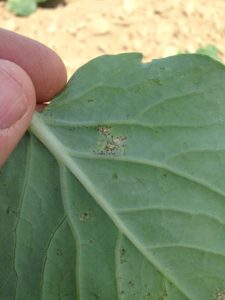Sweet Corn
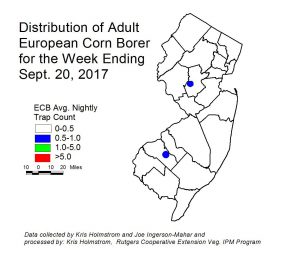 European corn borer (ECB) catches are still very low, but enough adults were caughted this week to register a map image. This pest is not much of a threat at this point, with most remaining plantings in silk. ECB feeding in less mature NJ sweet corn plantings is nearly non-existent now. Sprays for fall armyworm and corn earworm will manage any ECB larvae at this time.
European corn borer (ECB) catches are still very low, but enough adults were caughted this week to register a map image. This pest is not much of a threat at this point, with most remaining plantings in silk. ECB feeding in less mature NJ sweet corn plantings is nearly non-existent now. Sprays for fall armyworm and corn earworm will manage any ECB larvae at this time.
The highest nightly ECB catches for the previous week are as follows:
| Downer 1 | Medford 1 |
| Hillsborough 1 | Sergeantsville 1 |
| LittleYork 1 | South Branch 1 |
 Corn earworm (CEW) moth populations continued to increase over this past week with warmer weather sticking around (see CEW blacklight map at left). Several pheromone traps in south Jersey have gone offline as growers wrap up for the season, but remaining traps indicate a similar pattern. In this map, areas in green/red roughly correspond to a 3-day schedule, while blue areas are 4-5 days. White “holes” on the map represent traps that caught few or no CEW moths. These are outliers, and the broader color scheme in any particular region is more representative of the population. Be aware that synthetic pyrethroids have become less effective at managing ear infestations from this pest over the past several years. For this reason, it is advisable to include products in the IRAC group 28 (Coragen, Besiege) or IRAC group 5 (Radiant, Entrust (OMRI approved)).
Corn earworm (CEW) moth populations continued to increase over this past week with warmer weather sticking around (see CEW blacklight map at left). Several pheromone traps in south Jersey have gone offline as growers wrap up for the season, but remaining traps indicate a similar pattern. In this map, areas in green/red roughly correspond to a 3-day schedule, while blue areas are 4-5 days. White “holes” on the map represent traps that caught few or no CEW moths. These are outliers, and the broader color scheme in any particular region is more representative of the population. Be aware that synthetic pyrethroids have become less effective at managing ear infestations from this pest over the past several years. For this reason, it is advisable to include products in the IRAC group 28 (Coragen, Besiege) or IRAC group 5 (Radiant, Entrust (OMRI approved)).
It is important to note that sweet corn varieties containing Cry 1a proteins for caterpillar resistance (Attribute I types) are no longer providing adequate control of CEW. A trial at the Snyder Research and Extension Farm in Hunterdon County three weeks ago returned the following levels of ear infestation from CEW: Non-B.t. – 62%, Attribute I – 47%, and Attribute II – 2%. CEW pressure during this study was low to moderate. The same study, conducted at RAREC in Cumberland County and harvested last week returned the following CEW infestation rates: Non-B.t. – 96%, Attribute I – 100%, and Attribute II – 0%. CEW pressure during this study was moderately high. These studies indicate that Attribute I varieties should be treated for CEW following the recommended silk spray schedules for non-B.t. varieties.
The highest nightly CEW blacklight trap catches are as follows:
| Tabernacle 20 | Centerton 10 | Medford 7 |
| Eldora 13 | Downer 9 | Folsom 6 |
| Beckett 12 | Green Creek 9 | Woodstown 6 |
| Jobstown 11 | Springdale 8 | Elm 5 |
Southern NJ CEW pheromone trap catches remained fairly steady, although there are less traps operating now. This weeks’ map generally in synch with the blacklight map in terms of schedules (see CEW pheromone map below at right). Prolonged southerly airflow is keeping CEW with us for the time being. There are relatively few pheromone traps deployed compared to the number of blacklight traps in the state, resulting in much broader color bands on the pheromone map. Generally, the green portion of the map represents a 3-4 day schedule, while areas in red should adhere to a 3 day schedule.
At present, the highest nightly pheromone trap catches are as follows: 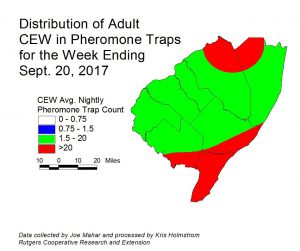
| Green Creek 57 | Beckett 3 |
| Jobstown 31 | |
| Berlin 16 | |
| East Vineland 9 | |
| Pole Tavern 6 |
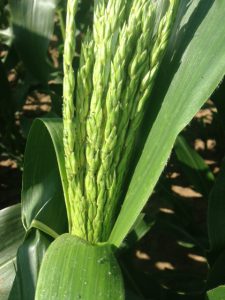 Many sweet corn plantings have developed populations of the corn leaf aphid (see photo at left). These aphids are not adequately controlled by pyrethroid insecticides and if not managed properly, will end up on the ears. If these aphids are detected in tassels, it is advisable to target them specifically with the first 1-2 silk applications. Lannate has generally been good in the past, although acetamiprid (Assail) is also labeled for aphid management in sweet corn. Assail will not control caterpillar pests, and must be applied in addition to the preferred caterpillar material.
Many sweet corn plantings have developed populations of the corn leaf aphid (see photo at left). These aphids are not adequately controlled by pyrethroid insecticides and if not managed properly, will end up on the ears. If these aphids are detected in tassels, it is advisable to target them specifically with the first 1-2 silk applications. Lannate has generally been good in the past, although acetamiprid (Assail) is also labeled for aphid management in sweet corn. Assail will not control caterpillar pests, and must be applied in addition to the preferred caterpillar material.
Silking Spray Schedules*:
South – 3 days
Central – 3 days
North – 4 days
*These recommendations are based on regional catches. Adhere to tighter spray schedules if indicated by local trap catches.
Pepper Weevil Update
Another farm was found with weevils in the Glassboro area. This is now a total of 6 farms in southern NJ and 3 processing facilities at or near which weevils have been trapped. It is doubtful that insecticide applications for weevils will be worthwhile at this time.
More fields are showing signs of pepper anthracnose fruit rot infections. This fungal disease causes depressions on the fruit surface, with pinkish spores developing soon after (see photo at right). Heavy rains can cause this disease to spread rapidly throughout a field, and infected fruit should be removed from the area during harvests. Appropriate fungicides to manage this disease in addition to fruit removal may be found in the Pepper section of the 2016-17 Commercial Vegetable Production Guide.
Pumpkins and Winter Squash
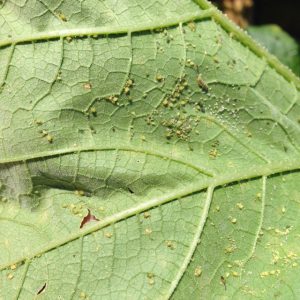 This is the time of year when melon aphid populations continue to appear in more pumpkin and winter squash fields. These aphids can build to extremely high levels in fields (see photo at left), resulting in sticky droppings accumulating on the surface of maturing fruit. If they are discovered in more than two sites in a 10 site sample, consider an application specifically to manage them. Useful materials include Fulfill and Assail, but a full list of recommended products may be found in the Pumpkin and Winter squash section Commercial Vegetable Recommendations.
This is the time of year when melon aphid populations continue to appear in more pumpkin and winter squash fields. These aphids can build to extremely high levels in fields (see photo at left), resulting in sticky droppings accumulating on the surface of maturing fruit. If they are discovered in more than two sites in a 10 site sample, consider an application specifically to manage them. Useful materials include Fulfill and Assail, but a full list of recommended products may be found in the Pumpkin and Winter squash section Commercial Vegetable Recommendations.
Cucurbit downy mildew (CDM) remains active on cucumber in NJ. It is important for all cucurbit growers to check the below website at least weekly for updates on the movements of CDM in the eastern U.S. (http://cdm.ipmpipe.org/). ALL cucurbit crops which need further maturation should be scouted for the presence of CDM. CDM causes yellow lesions to develop on the upper leaf surface. Lesions are confined within veins initially, but coalesce quickly to kill the entire leaf when moist conditions prevail. Beneath these lesions (lower leaf surface), dark gray spores will be produced. If discovered, please report any incidence of CDM to your county agent as soon as possible. It is useful to note that CDM is strictly a foliar disease, and if individual fields are to be harvested within 1-2 weeks, there is diminished value to the addition of systemic fungicides targeting CDM.
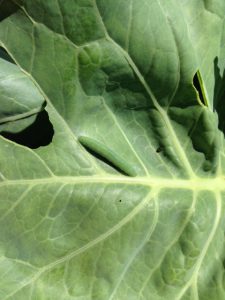 Late summer cole crop plantings are experiencing infestations, primarily from imported cabbageworm (ICW) (photo at left) and diamondback moth (DBM) larvae (photo at lower right). While both are damaging to these crops, DBM is more difficult to manage, as it is quite resistant to synthetic pyrethroid insecticides. DBM is effectively managed (along with all other caterpillar pests) with insecticides in the IRAC class 5 (Radiant, Entrust (OMRI approved)), and class 28 (Coragen, Exirel). DBM larvae are very small and are tapered toward both ends. They thrash violently when disturbed. ICW larvae grow larger and have a covering of velvety hairs as they grow. Check 5 consecutive plants each in 10 random sites within the planting. Consider treating if 10% or more
Late summer cole crop plantings are experiencing infestations, primarily from imported cabbageworm (ICW) (photo at left) and diamondback moth (DBM) larvae (photo at lower right). While both are damaging to these crops, DBM is more difficult to manage, as it is quite resistant to synthetic pyrethroid insecticides. DBM is effectively managed (along with all other caterpillar pests) with insecticides in the IRAC class 5 (Radiant, Entrust (OMRI approved)), and class 28 (Coragen, Exirel). DBM larvae are very small and are tapered toward both ends. They thrash violently when disturbed. ICW larvae grow larger and have a covering of velvety hairs as they grow. Check 5 consecutive plants each in 10 random sites within the planting. Consider treating if 10% or more 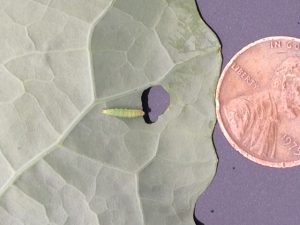 leafy cole crops are infested at any stage, or in heading types in the 0-9 true leaf stage. In heading types from 9 leaf to early head, a level of 20% plants infested may be acceptable. As heads form, the threshold should drop to 5% plants infested with any larvae, to protect the marketable portion of the plant.
leafy cole crops are infested at any stage, or in heading types in the 0-9 true leaf stage. In heading types from 9 leaf to early head, a level of 20% plants infested may be acceptable. As heads form, the threshold should drop to 5% plants infested with any larvae, to protect the marketable portion of the plant.
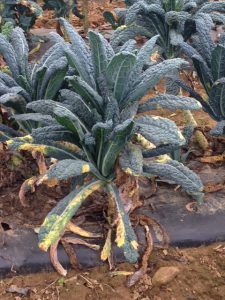 Black rot, a bacterial infection of cole crops is active on many plantings at this time. Black rot infections typically occur on mature foliage, initially resulting in yellow triangular lesions at the leaf margins (see photo at left). Lesions progress inward on leaves, and in some types (collards, kale, and some very susceptible yellow cauliflower varieties) can be economically destructive. Heat treatment of seeds is useful for limiting seed borne infections, but proper rotation is a must as well because the bacteria will persist on undecomposed host debris. Once an infection appears, copper sprays can help limit spread. Field workers should also avoid fields when foliage is wet.
Black rot, a bacterial infection of cole crops is active on many plantings at this time. Black rot infections typically occur on mature foliage, initially resulting in yellow triangular lesions at the leaf margins (see photo at left). Lesions progress inward on leaves, and in some types (collards, kale, and some very susceptible yellow cauliflower varieties) can be economically destructive. Heat treatment of seeds is useful for limiting seed borne infections, but proper rotation is a must as well because the bacteria will persist on undecomposed host debris. Once an infection appears, copper sprays can help limit spread. Field workers should also avoid fields when foliage is wet.
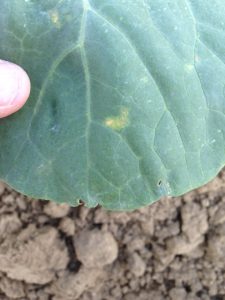 Crucifer downy mildew is also showing up now. It primarily infects broccoli, collards and kohlrabi, but can impact all cole crops. It causes small yellow lesions on the upper leaf surface (photo at left) on the lower surface, these lesions produce fine, whitish sporulation (photo at right). If you pass your cursor over the image, you may be able to increase the size enough to see the spore producing structures. For a complete listing of recommended fungicides for crucifer downy mildew see the Cole Crop section in the 2016-17 Commercial Recommendations Guide.
Crucifer downy mildew is also showing up now. It primarily infects broccoli, collards and kohlrabi, but can impact all cole crops. It causes small yellow lesions on the upper leaf surface (photo at left) on the lower surface, these lesions produce fine, whitish sporulation (photo at right). If you pass your cursor over the image, you may be able to increase the size enough to see the spore producing structures. For a complete listing of recommended fungicides for crucifer downy mildew see the Cole Crop section in the 2016-17 Commercial Recommendations Guide.

